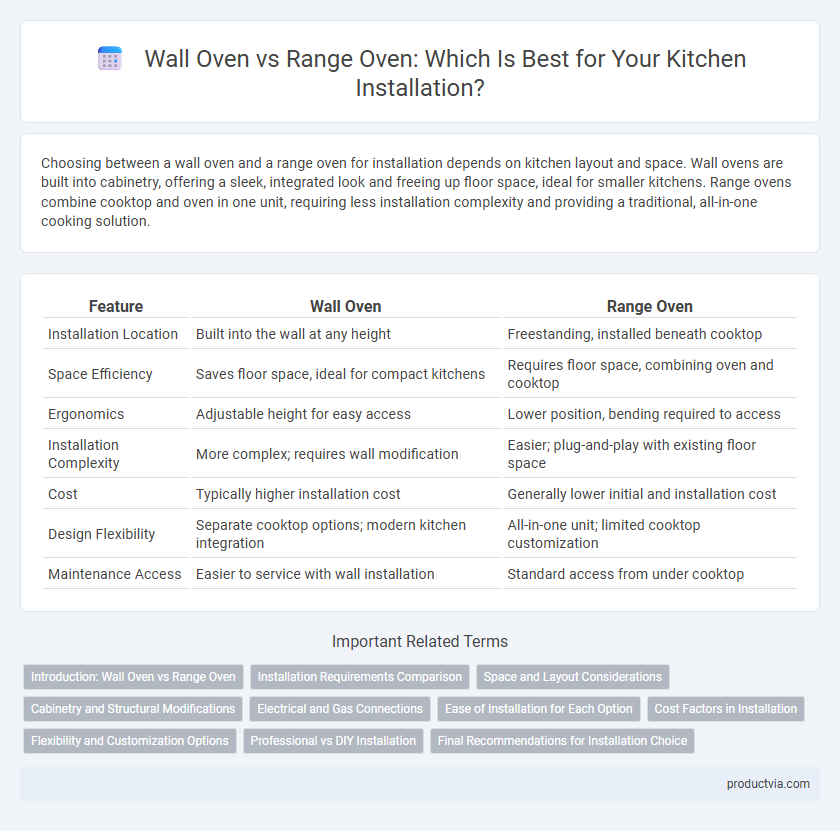Choosing between a wall oven and a range oven for installation depends on kitchen layout and space. Wall ovens are built into cabinetry, offering a sleek, integrated look and freeing up floor space, ideal for smaller kitchens. Range ovens combine cooktop and oven in one unit, requiring less installation complexity and providing a traditional, all-in-one cooking solution.
Table of Comparison
| Feature | Wall Oven | Range Oven |
|---|---|---|
| Installation Location | Built into the wall at any height | Freestanding, installed beneath cooktop |
| Space Efficiency | Saves floor space, ideal for compact kitchens | Requires floor space, combining oven and cooktop |
| Ergonomics | Adjustable height for easy access | Lower position, bending required to access |
| Installation Complexity | More complex; requires wall modification | Easier; plug-and-play with existing floor space |
| Cost | Typically higher installation cost | Generally lower initial and installation cost |
| Design Flexibility | Separate cooktop options; modern kitchen integration | All-in-one unit; limited cooktop customization |
| Maintenance Access | Easier to service with wall installation | Standard access from under cooktop |
Introduction: Wall Oven vs Range Oven
Wall ovens offer flexible installation options, allowing them to be built into cabinetry at eye level for ergonomic access and a sleek kitchen design. Range ovens combine a cooktop and oven in a single appliance, requiring installation beneath a countertop and saving space with an all-in-one unit. Choosing between the two depends on kitchen layout, cooking habits, and desired accessibility.
Installation Requirements Comparison
Wall ovens require dedicated built-in cabinetry with precise dimensions to ensure proper ventilation and secure mounting, often necessitating professional installation to meet electrical and safety codes. Range ovens are integrated with cooktops and typically need a standard 30-inch wide cabinet space, a compatible electrical outlet, and sufficient clearance for ventilation, making installation more straightforward but less flexible in terms of location. Evaluating kitchen layout, available space, and electrical capacity is crucial when choosing between wall oven and range oven installations.
Space and Layout Considerations
Wall ovens offer flexible installation options that save floor space and allow for a more streamlined kitchen layout by being built directly into cabinetry at convenient heights. Range ovens require a dedicated footprint, combining cooktop and oven in a single appliance, which can limit layout customization and consume more floor area. Choosing between the two depends on kitchen size, traffic flow, and personal preferences for ergonomics and design aesthetics.
Cabinetry and Structural Modifications
Wall ovens require built-in cabinetry spaces tailored to their dimensions, often necessitating custom cabinet modifications or replacements to accommodate the unit seamlessly. Range ovens, integrated with cooktops, generally fit into existing countertop cutouts and base cabinetry, minimizing structural changes during installation. Considering precise measurements and ventilation needs is crucial for both types to ensure safe and efficient placement within kitchen layouts.
Electrical and Gas Connections
Wall ovens typically require dedicated electrical circuits with 240 volts to support their heating elements, making them ideal for homes with specific wiring setups. Range ovens combine a cooktop and oven, often needing both gas and electrical connections depending on the model, which can simplify installation if existing connections align. Ensuring compatibility with local electrical codes and gas supply lines is crucial when choosing between wall and range ovens for installation efficiency.
Ease of Installation for Each Option
Wall ovens offer greater ease of installation in kitchens with existing cabinetry, as they require built-in space and standard electrical hookups, minimizing structural changes. Range ovens combine a cooktop and oven unit that simply slides into a designated space with existing gas or electric connections, often making installation quicker and less complex. Selecting between the two depends on kitchen layout, electrical or gas supply accessibility, and whether a seamless, integrated appearance or a standalone appliance is preferred.
Cost Factors in Installation
Wall ovens typically require custom cabinet modifications and electrical work, resulting in higher installation costs ranging from $500 to $1,500. Range ovens, which combine cooktop and oven in a single unit, often have lower installation expenses, usually between $100 and $500, due to simpler hookups and minimal cabinetry changes. Homeowners should also consider potential costs for ventilation adjustments and professional labor fees when comparing these two options.
Flexibility and Customization Options
Wall ovens offer greater flexibility and customization options by allowing installation at various heights, which improves accessibility and kitchen ergonomics. They can be paired with separate cooktops, enabling tailored kitchen layouts and the use of different cooking technologies. Range ovens integrate the cooktop and oven into one unit, limiting placement options but simplifying installation and saving space in compact kitchens.
Professional vs DIY Installation
Wall ovens typically require professional installation due to their built-in design and need for precise electrical and ventilation setup, ensuring safety and optimal performance. Range ovens, often combined with cooktops, are generally easier to install for DIY enthusiasts as they usually plug into standard outlets and do not require complex cabinetry modifications. Choosing between the two depends on the homeowner's skills, available tools, and willingness to handle electrical and structural work.
Final Recommendations for Installation Choice
Wall ovens offer a sleek built-in look and allow for flexible kitchen layouts, making them ideal for homeowners prioritizing design and space optimization. Range ovens provide a more traditional, all-in-one solution with integrated stovetop and oven components, simplifying installation in standard kitchen setups. For kitchens with limited space or where a customized aesthetic is desired, wall ovens are recommended; for more straightforward installations with combined cooking surfaces, range ovens remain the practical choice.
Wall Oven vs Range Oven for installation Infographic

 productvia.com
productvia.com